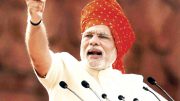A.O.Hume
When we think of India’s story of Independence, we start at 1857, the year Indian sepoys rebelled against the British. Indian history took a major turn after this. One happening was the birth of Indian National Congress (INC). It was founded with the help of Allen Octavian Hume, a retired British official. The first session of INC was held in Bombay in December 1885.
Azad Hind Fauj (Indian National Army)
Subhas Chandra Bose, who was President of the Congress in 1938 and 1939, resigned because he did not agree with Gandhi’s views. He formed the All India Forward Bloc. He opposed India joining World War II (WWII). In 1940, the British put Bose under house arrest in Calcutta. He escaped to Nazi Germany hoping to raise an army with Hitler and Mussolini’s help to fight the British. Hitler advised Bose to go to Japan and arrange for a submarine. Bose reorganised the defunct Indian National Army. The Azad Hind Fauj or INA fought the British Indian army in Arakan, Burma and Assam with the Japanese Army. But the INA could not sustain itself and surrendered to the British in 1945.
B engal Partition, 1905
The British rule in India has been recognised as one of “divide and rule”. So when Lord Curzon, Viceroy and Governor-General ordered Bengal to be broken into two for “better administration”, it was clear the action was meant to separate Hindus and Muslims into two areas. The partition made the Bengalis very angry. Nationalists such as Sri Aurobindo, Bhupendranath Datta and Bipin Chandra Pal wrote strong newspaper articles against the British rule. King George V cancelled the partition of Bengal, which was eventually unified in 1911.
C ripps Mission
Needing help with WWII, the British government sent a delegation to India under Stafford Cripps. Its mission was to get total co-operation of the Congress and the Indian leaders for Britain’s war. In return Indians would be given more power in elected legislatures. They could make their own constitution. Cripps’ Mission failed. Why only dominion-status under British rule, the leaders asked. Where is the time-frame for self-government? Gandhi made the famous call: Let’s “Do or Die”.
D andi March
In January 1930, Gandhi demanded the abolition of salt tax. Gandhi threatened to begin a disobedience campaign if the demands were not met. With demands not met, on 12 March, 1930, with volunteers, Gandhi started walking from Sabarmathi Ashram to Dandi. Thousands joined him en-route. On 6 April 1930 Gandhi reached Dandi, and made salt symbolically by boiling sea water. It meant Indians had the right to make salt and would not pay salt tax. Satyagrahis were attacked. A worried Gandhi agreed to attend the second Round Table Conference if political prisoners were released.
E ast India Company
In the Battle of Plassey of 1757, Robert Clive and the East India Company’s Indian army defeated the Nawab of Bengal, successfully fought the Battle of Buxar in 1764 and began to rule areas of Bengal, Bihar and parts of Orissa. In south India, the East India Company’s army defeated Tipu Sultan and most of South India came either under the Company’s direct or indirect rule. It spread its control over regions ruled by Marathas too. The East India Company’s authority in India came to an end with the sepoy mutiny.
F irst to Third Round Table Conferences
As Indian leaders continued to demand independence, the British called for a Round Table Conference in 1930 to consider the constitution of India. The Simon Commission, booed in India, had recommended measures from the Government of India Act of 1919. The report was published in 1930. The conference was held in London. The session (November 12, 1930 to January 19, 1931) had 73 representatives from all Indian States and all parties except the Congress, busy with civil disobedience campaign. The members agreed on a parliamentary form of government for India as a dominion under the British king. The second session ( September 7 to December 1, 1931) was attended by Mahatma Gandhi as the Congress representative. He rejected communal representation and asked for constitutional reforms for self-rule, which the British did not agree to. Neither the Congress nor the British Labour Party attended the third session (November 17 to December 24, 1932). The RTCs failed.



Be the first to comment on "Indian Independence:story of A-Z Independence"